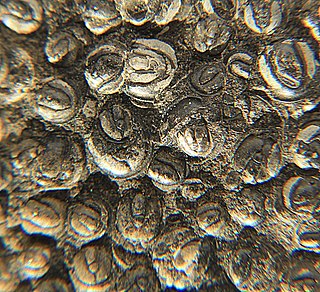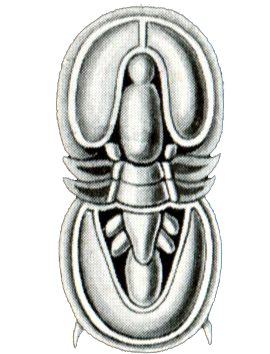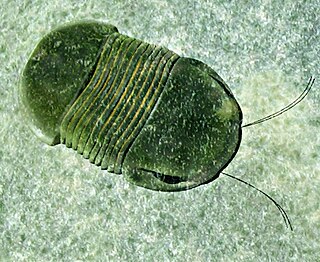
Trilobites are extinct marine arthropods that form the class Trilobita. Trilobites form one of the earliest known groups of arthropods. The first appearance of trilobites in the fossil record defines the base of the Atdabanian stage of the Early Cambrian period and they flourished throughout the lower Paleozoic before slipping into a long decline, when, during the Devonian, all trilobite orders except the Proetida died out. The last trilobites disappeared in the mass extinction at the end of the Permian about 251.9 million years ago. Trilobites were among the most successful of all early animals, existing in oceans for almost 270 million years, with over 22,000 species having been described.

Asaphida is a large, morphologically diverse order of trilobites found in marine strata dated from the Middle Cambrian until their extinction during the Silurian. Asaphida contains six superfamilies, but no suborders. Asaphids comprise some 20% of described fossil trilobites.

Ptychopariida is a large, heterogeneous order of trilobite containing some of the most primitive species known. The earliest species occurred in the second half of the Lower Cambrian, and the last species did not survive the Ordovician–Silurian extinction event.

The Furongian is the fourth and final epoch and series of the Cambrian. It lasted from 497 to 485.4 million years ago. It succeeds the Miaolingian series of the Cambrian and precedes the Lower Ordovician Tremadocian Stage. It is subdivided into three stages: the Paibian, Jiangshanian and the unnamed 10th stage of the Cambrian.

The Emu Bay Shale is a geological formation in Emu Bay, South Australia, containing a major Konservat-Lagerstätte. It is one of two in the world containing Redlichiidan trilobites. The Emu Bay Shale is dated as Cambrian Series 2, Stage 4, correlated with the upper Botomian Stage of the Lower Cambrian.

Isotelus is a genus of asaphid trilobites from the Middle and Late Ordovician Period, fairly common in the northeastern United States, northwest Manitoba, southwestern Quebec and southeastern Ontario.

Deiphon is a distinctive genus of Silurian phacopid trilobites of the family Cheiruridae found in Western and Central Europe, and in Central and Eastern United States. The type species, D. forbesi, from England, Bohemia, and Sweden, was discovered and described by the French paleontologist, Joachim Barrande in 1850.

Agnostus is a genus of agnostid trilobites, belonging to the family Agnostidae, that lived during the late Middle Cambrian – early Upper Cambrian. It is the type genus of the family Agnostidae and is subdivided into two subgenera, Agnostus and Homagnostus.
Ananaspis is a genus of trilobite in the order Phacopida, which existed in what is now the Czech Republic. It was described by Campbell in 1967, and the type species is Ananaspis fecundis, which was originally described as Phacops fecundus communis by Barrande in 1852.
Calymenella is a genus of trilobites in the order Phacopida, which existed in what is now France during the upper Ordovician. It was described by Bergeron in 1890, and the type species is Calymenella boisseli. The species was described from the Glauzy Formation in the Montagne Noire mountain range.

Chasmops is a trilobite in the order Phacopida that existed during the upper Ordovician in what is now Estonia. It was described by McCoy in 1849, and the type species is Chasmops odini, which was originally described under the genus Calymene by Eichwald in 1840. It also contains the species C. maxima.

Encrinuroides is a genus of trilobites in the order Phacopida, that existed during the upper Ordovician in what is now Wales. It was described by Reed in 1931, and the type species is Encrinuroides sexcostata, which was originally described under the genus Cybele by Salter in 1848. It also contains the species, Encrinuroides enshiensis, Encrinuroides insularis, and Encrinuroides rarus. The type locality was in the Sholeshook Limestone Formation.
The Walcott–Rust quarry, in Herkimer County, New York, is an excellent example of an obrution Lagerstätte. Unique preservation of trilobite appendages resulted from early consolidation (cementation) of the surrounding rock, followed by spar filling of the interior cavity within the appendages. The presence of so many well preserved trilobites in one location alone qualifies the beds as an exceptional trilobite site, but the beds are further distinguished as the source of the first trilobites for which appendages were definitively described.
The cephalon is the head section of an arthropod. It is a tagma, i.e., a specialized grouping of arthropod segments. The word cephalon derives from the Greek κεφαλή (kephalē), meaning "head".

Agnostidae is a family of Agnostida trilobites. Like all Agnostina, they were eyeless and had only two thoracic segments. These trilobites inhabited benthic waters worldwide from 508 to 461 million years ago. The family includes the following genera, among others:
Micragnostus is a genus of trilobites in the order Agnostida, which existed in what is now north Wales. It was described by Howell in 1935, and the type species is Micragnostus calvus, which was originally described as a species of Agnostus by Lake in 1906.
Phalacroma is a genus of trilobite in the order Agnostida, which existed in what is now the Czech Republic. It was described by Hawle and Corda in 1867, and the type species is Phalacroma bibullatus, which was originally described as a species of Battus by Barrande in 1846.

Bumastus is an extinct genus of corynexochid trilobites which existed from the Early Ordovician period to the Late Silurian period. They were relatively large trilobites, reaching a length of 6 in (15 cm). They were distinctive for their highly globular, smooth-surfaced exoskeleton. They possessed well-developed, large compound eyes and were believed to have dwelled in shallow-water sediments in life.
Raymondaspis is a genus of trilobites in the family Styginidae. It was described by Pribyl in 1949, and contains the species R. reticulatus and R. turgidus from the Whiterockian of Canada, R. vespertina from the Ordovician and Whiterockian of the United States and Norway, and a new species, R. grandigena, which existed during the Middle Ordovician of what is now Sweden. R. grandigena was described in 2012 by Martin Stein and Jan Bergström.

Paleontology in Wisconsin refers to paleontological research occurring within or conducted by people from the U.S. state of Wisconsin. The state has fossils from the Precambrian, much of the Paleozoic, some parts of the Mesozoic and the later part of the Cenozoic. Most of the Paleozoic rocks are marine in origin. Because of the thick blanket of Pleistocene glacial sediment that covers the rock strata in most of the state, Wisconsin’s fossil record is relatively sparse. In spite of this, certain Wisconsin paleontological occurrences provide exceptional insights concerning the history and diversity of life on Earth.












